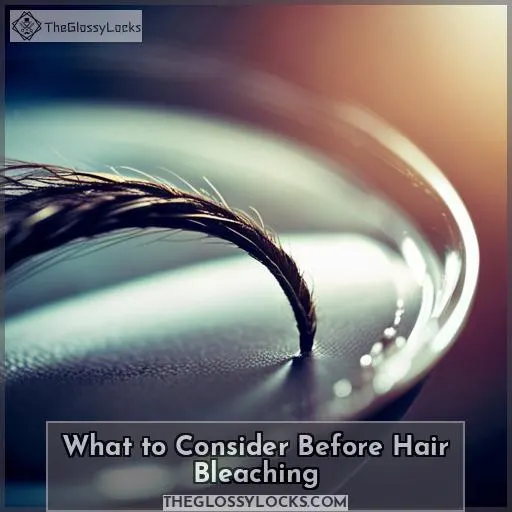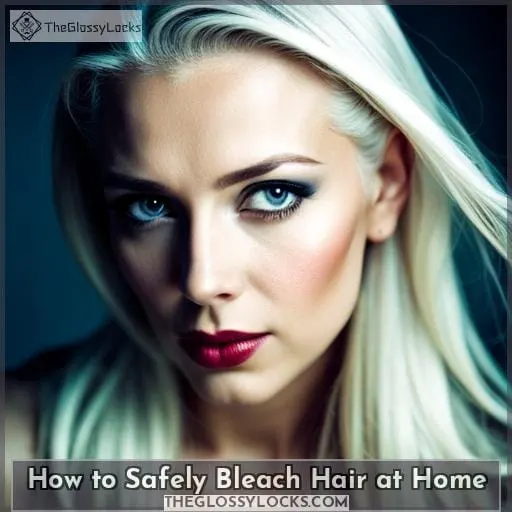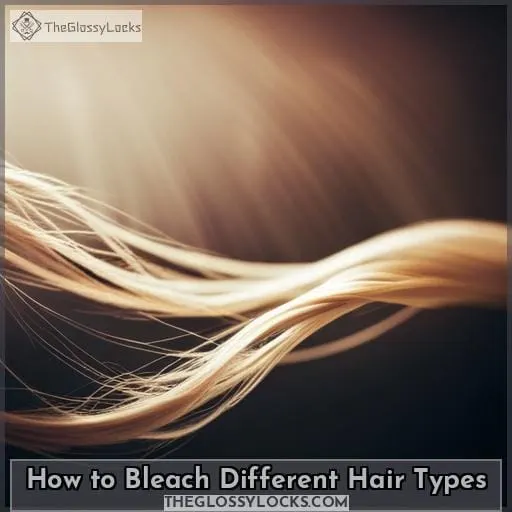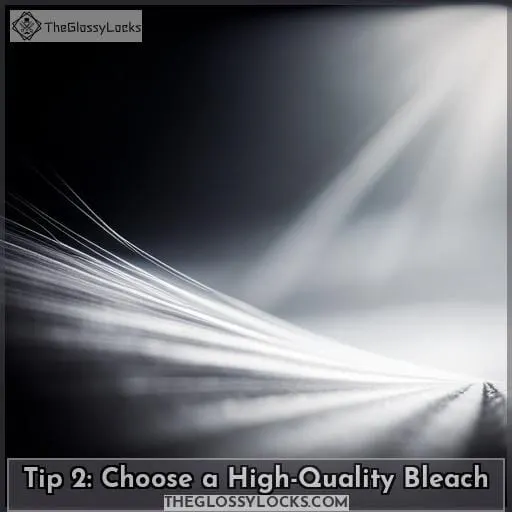This site is supported by our readers. We may earn a commission, at no cost to you, if you purchase through links.
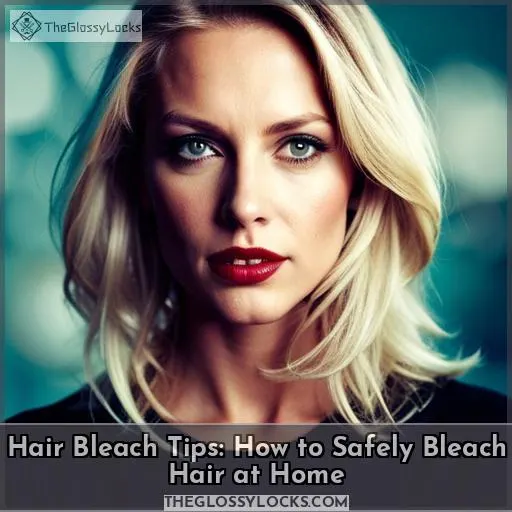
Hair bleach can be tricky business. If done incorrectly, severe damage may occur on all types of hair – from black or dark brown hair through white or gray locks.
Table Of Contents
Key Takeaways
- Assess hair quality and condition before bleaching.
- Use high-quality bleach and developer products.
- Follow recommended processing times and developer strengths.
- Take proper care of hair post-bleaching to maintain results.
What to Consider Before Hair Bleaching
Before you attempt to bleach your hair, it is important to understand the quality of your hair and what preparation is necessary. Consider factors such as whether it’s virgin or previously colored, its hydration level, coarseness, and history in order to ensure a successful bleaching process with minimal damage.
Hair Quality
Before bleaching your hair, consider its condition and history for the best results. At-home bleachers should assess their hair’s hydration, coarseness, and prior color treatments before taking any steps towards coloring.
Professional stylists will also inquire about these factors during a hair quality assessment when offering bleach services in-salon or virtually.
Depending on the initial state of your tresses – whether natural blonde or textured dark brown – different products may be used for safe bleaching at home or professional application with precision. The developer strength should reflect how many levels you’re trying to lift. 20 Vol is typically sufficient if lightening 1-2 tones, while 30 Vol is better suited for 3+ shades difference from the original coloration.
When it comes time to apply bleach, make sure you mix at a ratio of 1:2 product to developer and avoid starting too close to the scalp! Keep an eye on processing times as well. The maximum processing time should be 45 minutes in total, but shorter exposure may be needed depending on the desired outcome, whether lighter or darker.
With proper care before and after treatment, as well as choosing the right products based on individual needs and goals, successful results are achievable with some practice!
Hair Bleaching Preparation
Gather the essential tools and products for a successful bleaching session, from bleach to shampoo, so you can confidently create beautiful hair color.
Before starting your process, assess your hair’s quality – it’s important to determine if a lightening service may cause any porosity issues. If so, consider conditioning treatments before bleaching and reduce the strength of developer used when applying the bleach mixture.
To ensure maximum lift with minimal damage, use high-quality products like Magnet™ Blondes Ultimate Powder 7 with Bond Protect. You can also add in Magnet™ Ultimate Technical Additive for enhanced strengthening benefits.
Divide hair into sections, then apply the colored product carefully, following package instructions accordingly.
Post-bleach care is crucial. Be sure to include nourishing supplements or deep conditioners.
With these tips in mind, you’ll have strong, healthy locks that will wow everyone around you after each professional bleaching visit!
How to Safely Bleach Hair at Home
Are you looking to safely bleach your hair at home? Processing time, application techniques, and at-home color maintenance are all important considerations before bleaching. Learn how to properly apply the bleach, calculate processing times based on your desired shade of blonde, and maintain vibrant color with professional-grade products for the best results.
Processing Time
Take note of the processing time indicated in your product instructions for the best bleaching results. Based on hair type and color, techniques such as balayage may require up to 45 minutes of processing time.
For black or dark brown hair, multiple sessions and toning may be necessary. Avoid lightening more than three tones at once since this can result in damage. Choose a developer strength that’s suitable for the desired lift – 20 Vol is enough for 1-2 levels, while 30 Vol can lift further.
During application, start one inch away from the scalp and work down gradually section by section without exceeding the maximum timing set out in the instruction booklet.
Application Techniques
Section your strands into four equal parts and methodically apply the bleach like a painter’s brush to create highlights that pop. For a soft, natural look, opt for the Balayage technique or root touch-ups. Protect your scalp by covering it with Vaseline or an oil-based product before starting.
Remember to keep your hair hydrated by using deep conditioners before and after bleaching if you have previously damaged hair from bleach. If you’re considering professional coloring, Collagen treatments can help maintain healthy locks while still achieving stunning results without damage from harsh products.
At-Home Color Maintenance
Maintain your newly bleached hair color by using special products and treatments tailored to blonde locks. Hair care supplements can help repair damaged strands for stronger, healthier hair. Color maintenance products like Blondify toners are formulated specifically for lightened shades and prevent fading between at-home bleachings or salon visits.
DIY techniques, such as root touch-ups with store-bought dye, will keep blondes looking fresh in between appointments, while specialized home bleaching kits allow you to get the perfect shade without sacrificing your hair health! With a little bit of care, you can have beautiful blonde locks that stay vibrant longer.
How to Bleach Different Hair Types
Are you considering bleaching your hair? It’s important to take into account the type of hair that you have. Black or dark brown hair requires multiple sessions for gradual lightening, textured locks need specific cool-toned shades with added hydration afterward, white or gray strands require careful processing time and toning, while previously bleach-damaged tresses call for restructuring treatments.
Black or Dark Brown Hair
Throwing it back to the basics, if you’ve got black or dark brown hair, gradual lightening is key for avoiding breakage and getting a salon-worthy result. Always use 20 Vol developer and divide your hair into sections before application.
Take extra care not to start too close to the scalp; begin an inch away from roots instead.
The maximum processing time should be 45 minutes—any more could cause irreversible damage! After bleaching, nourish your locks with coconut oil products like Re/Start™ Recovery Anti-Split Ends Sealing Drops and cool toned shades for textured strands.
Tone with cream or liquid demi-permanent solutions afterward as necessary for optimal results without compromising on the health of dark brown tresses.
Textured Hair
For textured hair, cool-toned shades and hydration are key after bleaching. Bleaching textured locks requires acidic formulations to ensure the cuticle isn’t damaged or over processed during lift. Hair color experts recommend using platinum blonde tones for a natural look that won’t appear too harsh against coiled tresses.
To care for bleached texture, avoid sulfates and apply nourishing treatments regularly. Coconut oil products like Re/Start Recovery Anti-Split Ends Sealing Drops help keep strands healthy while styling with heat tools like curling irons or flatirons.
Maintaining a beautiful platinum shade on textured hair takes dedication, but it’s worth every effort!
White or Gray Hair
If you have white or gray hair, its special needs require extra care when bleaching. Analyze your color to determine the best toner and developer strength for a gentle lift. Vegan bleach options like Manic Panic can be used to lighten eyebrows too! Consider Hush Hair Supplement for improved texture and growth post-bleach.
Previously Bleach-Damaged Hair
Previously bleach-damaged hair requires restructuring and nourishing treatments to restore its health. Celebrity colorists suggest using bond protect with Brilliant Blondexx powder for a gentle yet effective lift.
Additionally, rebuilding strands is essential; try Ugly Duckling’s formulations that work on all levels of black hair. For ongoing recovery, use purple shampoo and mask once a week to neutralize brassy tones without staining the scalp or shafts.
Tip 1: Calculate the Level of Lift Needed
When it comes to bleaching hair, a key step is calculating the level of lift needed. To do this accurately, you’ll need both a regrowth hair level chart and one for previously lightened hair color levels.
Regrowth Hair Level Chart
Easily calculate the level of lift you need for your regrowth hair with a helpful chart! For professional coloring, analyze the client’s hair and choose products carefully. Look at charts to assess regrowth and previously lightened levels before bleaching application.
Once prepared, divide into sections and apply bleach thoroughly based on technique used – from root touch-up to full platinum makeover! To keep post-bleach hair healthy, dietary supplements like Hush Hush Hair Supplement can reduce shedding while boosting volume.
Root color treatments like store-bought colors or Madison Reed’s Balayage Kit offer gentle options too – plus intense cream toners for dark locks.
Previously Lightened Hair Level Chart
Compare previously lightened hair levels using a chart to ensure the right amount of lift. If you’ve dyed your hair before, it’s important to know how many shades lighter you can go without causing damage or breakage.
Using an accurate level chart helps identify your current shade and successfully target the desired color with minimal risk. Start by consulting professional stylists who specialize in lightening techniques for advice on which type of bleach will be suitable for your hair type and texture.
They can also recommend conditioning treatments that may help achieve better results.
To lighten your hair at home, consider using odor-free bleaching solutions like Manic Panic’s Bleach Kit. This kit is perfect for those looking to reach medium blonde or lighter tones safely.
For optimal maintenance and growth after bleaching, you can also take dietary supplements such as Hush Hush Hair Supplement. Reviews suggest that this drug-free supplement can reduce shedding and increase volume within 90 days when used regularly.
Additionally, using quality toners from Ugly Duckling’s range can help maintain your desired hair color.
Tip 2: Choose a High-Quality Bleach
Choosing a high-quality bleach is essential for achieving the desired lift levels while preventing hair breakage. The Manic Panic Bleach Kit and Brilliant Blondexx with Bond Protect are two vegan, cruelty-free formulas that can help you achieve the perfect blonde without compromising your precious locks.
Importance of high-quality bleach
When it comes to bleaching, quality is key; investing in a high-quality bleach will guarantee long-lasting results.
Benefits of vegan bleach include:
- No harsh chemicals or animal products used
- Reduced risk of scalp irritation and hair damage
- Easier to use than traditional formulas
Dietary supplements for hair can also help achieve optimal lift without exposing your locks to more chemical processing.
Bleaching safety tips such as using the correct developer strength and respecting maximum processing times are essential for successful lightening.
Choosing the right developer helps prevent breakage while delivering desired results with minimum effort – a must when going blonde!
Preventing hair breakage
Choose a high-quality bleach like Brilliant Blondexx with Bond Protect to prevent hair breakage and ensure your bleaching success. Applying the right bleach techniques, such as proper developer strength and product saturation, is key for successful results.
Hydrate your locks prior to bleaching; avoid sulfates/alcohol shampoos after processing, minimize heat styling, and use coconut oil products like Re/Start™ Recovery Anti-Split Ends Sealing Drops.
Achieving desired lift levels
To achieve the desired lift levels, use a high-quality bleach like Brilliant Blondexx with Bond Protect – it’ll be your BFF for bleaching! Select the right developer strength – 20 Vol for 1-2 levels lift, 30 Vol for more.
Make sure you mix in a ratio of 1:2 bleach to developer and saturate thoroughly using balayage technique.
After color maintenance and root touch up, the vegan Manic Panic Bleach Kit is great too! It has a dust-free formula that lifts hair up to five levels and low odor properties. Even beginners can achieve their desired results – medium blonde to light blonde shades.
Tip 3: Select the Right Developer Strength
It is essential to select the right developer strength when bleaching hair. For 1-2 levels of lift, use 20 Vol; for more than 2 levels, use 30 Vol – never exceed 40 Vol. With this in mind, choosing a high-quality bleach and proper concentration will ensure successful results without causing damage to the hair.
Importance of developer strength
It’s essential to choose the right developer strength for successful bleaching, as it can affect how well your hair lifts and the amount of damage caused. For 1-2 levels lifting, use 20 Vol; for more than two levels lift, opt for 30 Vol developer.
To ensure good product saturation with minimal damage done to your hair during application, mix a ratio of 1:2 bleach powder and developer respectively. When dealing with textured or previously bleached hair, consider using cool-toned shades and providing extra nourishing treatments afterward.
Properly assessing each client’s unique needs is key in achieving desired results while maintaining healthy hair quality over time.
Recommended developer levels
For optimal results, use 20 Vol developer for 1-2 levels of lift and 30 Vol for more. Assess hair quality when applying bleach to determine if a stronger or weaker strength is needed. Understand the desired lift level and use the right techniques for home maintenance.
Professional coloring involves an in-depth assessment to ensure product saturation without overprocessing. Trust brands like Brilliant Blondexx with Bond Protect for lifting well while protecting your locks from damage.
Avoid using 40 Vol
When selecting the right developer strength, avoid using 40 Vol as it can cause serious damage to hair. A case study reported brittle and dry breakage in previously healthy tresses due to over-bleaching with 40 Vol.
To get the best results for your client’s hair type and color, assess their quality first before deciding on a processing time between 20–30 Vols of developer.
Toning techniques should also be tailored based on the desired level of lift. For black or dark brown hair, multiple sessions may be needed, while textured locks require cool shades and hydration after bleaching.
Lastly, apply bleach carefully, following application tips from experts like Ryan Pearl or Guy Tang, for stunning professional results every time!
Conclusion
If you want to bleach your hair but are scared of the potential damage, it’s time to get informed. Hair bleaching requires careful preparation and knowledge of the process. Before starting, consider your hair quality and decide whether to use a professional or an at-home bleach kit.
Once you have the products, tend to your hair’s health and apply the bleach in small sections, following the instructions on the package. Depending on your hair type, you may need to apply multiple treatments. Utilize the right developer strength and bleach quality for an optimal result and use purple shampoo and a hair mask after the process to avoid yellow tones.
Mastering professional hair bleaching requires a bit of knowledge, but with the right tips, you can keep your hair healthy and achieve the desired color.

